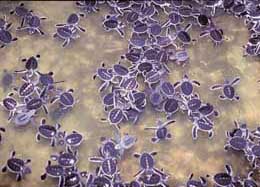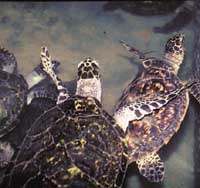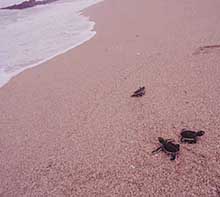





 |
Part IV of our series on the environment with
Studio Times

By Charith Pelpola Pix by Nihal Fernando

The greatest of trag- edies is the slaughter of the
turtles themselves. This activity is illegal, but the extent of turtle
killing, like the collection of their eggs, is island- wide and out of
sight. A turtle's temperament makes it easy prey to the fisherman's net.

With few natural predators in adulthood, it flees from the approach of
a catamaran with a certain reluctance. And once in the boat, its fate is
sealed.
Onshore, the animal is flipped on to its back. Powerless and unable
to act against its oppressors, the turtle flails pathetically at the air
with useless flippers. A man will come close, and using a sharp curving
blade, will prise the protective ventral carapace from its body. As the
blood spills, the same knife is used to dissect portions of the living
flesh from the dying animal.
 And
the flesh quivers as it is removed; holding on to the last pulse of life
until it finally drains away with the blood and the salt water, into the
sand. A long line of smiling villagers wait to take their share. Through
it all, the turtle makes no sound. The flailing limbs will move with less
energy, until they are defunct and quite still. The turtle's eyes will
stare, fathomless and glazed. And
the flesh quivers as it is removed; holding on to the last pulse of life
until it finally drains away with the blood and the salt water, into the
sand. A long line of smiling villagers wait to take their share. Through
it all, the turtle makes no sound. The flailing limbs will move with less
energy, until they are defunct and quite still. The turtle's eyes will
stare, fathomless and glazed.
Mucus, saline tears will weep through the ordeal, and long after its
life has been taken. An empty shell will lie abandoned on the shore; and
scavengers will take their pick.
Inhuman and yet so typical of us. We find it difficult to accept that
we are capable of such barbarism. It is much easier to turn the page and
forget the words. A mouth is fed for one day. A life is lost forever.
How turtles get around
In a life span of 60-70 years, a turtle may travel thousands of kilometres
from its birth place, but it always finds its way back to the same spot
or some place close to it, whenever it lays eggs.
This intriguing and unerring instinct is now being attributed to the
fact that turtles rely on the earth's magnetic field to reach their destination.
The intensity of the magnetic field and the inclination of the region
in which the turtles travel, are both inconsistent because they vary with
changing directions. They form a sort of grid, much like the one made by
latitudes and longitudes. Therefore, any point on the earth is marked by
both the magnetic intensity and inclination.
Since turtles can make out both these features, in all possibility they
must be mentally creating a " magnetic map" and using it to get
around. - 'Down to Earth 1996.
|
|





 And
the flesh quivers as it is removed; holding on to the last pulse of life
until it finally drains away with the blood and the salt water, into the
sand. A long line of smiling villagers wait to take their share. Through
it all, the turtle makes no sound. The flailing limbs will move with less
energy, until they are defunct and quite still. The turtle's eyes will
stare, fathomless and glazed.
And
the flesh quivers as it is removed; holding on to the last pulse of life
until it finally drains away with the blood and the salt water, into the
sand. A long line of smiling villagers wait to take their share. Through
it all, the turtle makes no sound. The flailing limbs will move with less
energy, until they are defunct and quite still. The turtle's eyes will
stare, fathomless and glazed. 
